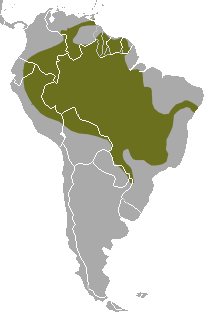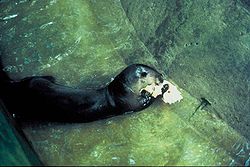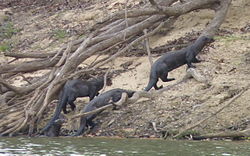Giant otter
The giant otter or giant river otter (Pteronura brasiliensis) is a type of otter. It is the longest type of mustelid. It can grow up to 1.7 metres (5.6 ft). The giant otter is diurnal. It is the noisiest type of otter. The giant otter is the largest type of otter in the world.[1]
| Giant otter | |
|---|---|

| |
| Cuiaba River, Mato Grosso do Sul, Brazil | |
| Conservation status | |
| Scientific classification | |
| Kingdom: | Animalia |
| Phylum: | Chordata |
| Order: | Carnivora |
| Family: | Mustelidae |
| Genus: | Pteronura Gray, 1837 |
| Species: | P. brasiliensis
|
| Binomial name | |
| Pteronura brasiliensis (Gmelin, 1788)
| |

| |
| Giant otter range | |
Giant Otter Media
Giant otter head from the Museu Paraense Emílio Goeldi research institute
A wild giant otter "periscoping" in Cantão State Park in Brazil, showing its identifying throat marks
Skull seen from the side. Short-snouted as usual in mustelids, it has a pronounced sagittal crest, allowing for a very powerful bite in this species.
Giant otters leave a pool together at the Philadelphia Zoo. The species is extremely social, a rarity among mustelids, and family groups are cohesive.
A giant otter den dug on a lakeshore at Cantão State Park – the newly dug white sand is a sign of recent activity at this den.
Giant otter from Venezuela
References
- ↑ Wilson, Don E.; Reeder, DeeAnn M. (2005). Mammal Species of the World: A Taxonomic and Geographic Reference. JHU Press. ISBN 978-0-8018-8221-0.










